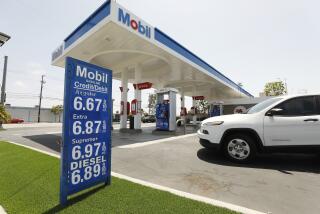Higher Price, Not Government Policy, Fuels the Supply Equation
- Share via
Efforts to boost domestic oil and natural gas production will depend far more on the price those commodities fetch than on any policy or incentives the Bush administration has proposed, some analysts said Thursday.
President Bush’s efforts largely won’t be felt for years to come and, in themselves, would mean little relief for California consumers, who already are chafing under tight supplies and surging prices for gasoline and natural gas.
The higher the price they can get for oil and natural gas, the more money energy companies are willing to invest to find and bring the resources to the surface. As prices have risen during the last year, there has been a sharp increase in exploration here and abroad.
“The Bush plan will help to encourage companies to develop natural gas properties, but high prices are an even stronger incentive,” said Bruce Schwartz, an analyst at Standard & Poor’s Corp.
The Bush policy proposals come at a time when both commodities remain plentiful in U.S. fields, analysts said.
Although market prices are key, some analysts agreed that the administration’s efforts could play a major role in removing barriers to domestic energy output, assuming that they survive environmental challenges.
The easing of regulatory and permit issues, along with the potential for opening some federal lands to production, could mean added exploration in Alaska and the Gulf of Mexico in particular, said David Pursell, a vice president at Simmons & Co., a Houston-based investment banker that specializes in energy.
For example, the Bush plan could accelerate efforts by energy companies to use “floating production systems” to pump and deliver more natural gas from the deep waters of the Gulf of Mexico.
These systems rely on an armada of tankers and other floating devices--rather than more expensive fixed pipelines that stretch from the drilling platforms to the coastline--to deliver the gas, and Bush’s energy plan could “streamline the approval processes” for developing more such systems, Pursell said.
Estimates of U.S. oil and gas reserves vary widely. But the most recent research by the U.S. Geological Survey estimates that, as of 1995, there were 110 billion barrels of oil domestically, up a sharp 41% from 78 billion in a 1989 survey. One big reason for the gain: new technology that is better able to detect and recover available reserves. (These figures cover only onshore reserves and those in offshore waters controlled by the states, and exclude oil available in federal waters.)
The USGS also estimated that 580 trillion cubic feet of natural gas were technically recoverable, up from 347 trillion in the 1989 survey.
To put that number into context, domestic supplies of natural gas “have stayed relatively constant in recent years,” said Larry Foster, who heads the natural gas publications for Platts, a unit of McGraw-Hill Cos. About 20 trillion to 22 trillion cubic feet of U.S. gas are produced each year, but new discoveries of gas fields “have pretty much kept pace with that production,” he said.
Foster said the Bush plan, “to a very minor extent,” would help increase gas production.
“What is driving interest in gas exploration right now by far is the current market price,” which is double what it was a year ago.
“The prospects are that [gas prices] are not going to drop too significantly the next couple of years, and so the attraction of those prices is far stronger [to energy companies] than anything we saw in the report,” Foster said.
With regard to crude oil, the Bush plan would do very little to persuade the industry to step up production at most U.S. fields when “there are other [foreign] sources of oil that are lower cost,” said Philip Verleger Jr., an energy economist with the Brattle Group, a consulting firm based in Cambridge, Mass.
“It’s still cheaper for oil companies to explore and produce oil in non-U.S. sites, excluding those already set up in Alaska,” he said.
Alaska, in fact, remains a central component in the U.S. energy debate.
The president’s package includes efforts to expedite oil production now prohibited on federal land at the Arctic National Wildlife Refuge in northern Alaska. The USGS has estimated that 10 billion barrels of oil might be available there.
“You’re talking about another Prudhoe Bay,” said Pursell, referring to the huge North Slope fields discovered in 1968.
In addition to its large potential volume, oil recovered from the refuge would have the advantage of being shipped via the existing trans-Alaskan pipeline to the port of Valdez, then put aboard tankers to the West Coast.
“If you’re looking for areas to encourage drilling, ANWR makes sense,” he said.
But ultimately it remains unclear to what extent any federal policy can influence greater development of energy commodities in the long term, given the influence of market forces, analysts said. The boom-and-bust cycles of the past illustrate that an influx of new energy supplies tends to cause prices to drop--and thus dampens a key incentive for industry to keep drilling for more.
More to Read
Inside the business of entertainment
The Wide Shot brings you news, analysis and insights on everything from streaming wars to production — and what it all means for the future.
You may occasionally receive promotional content from the Los Angeles Times.











